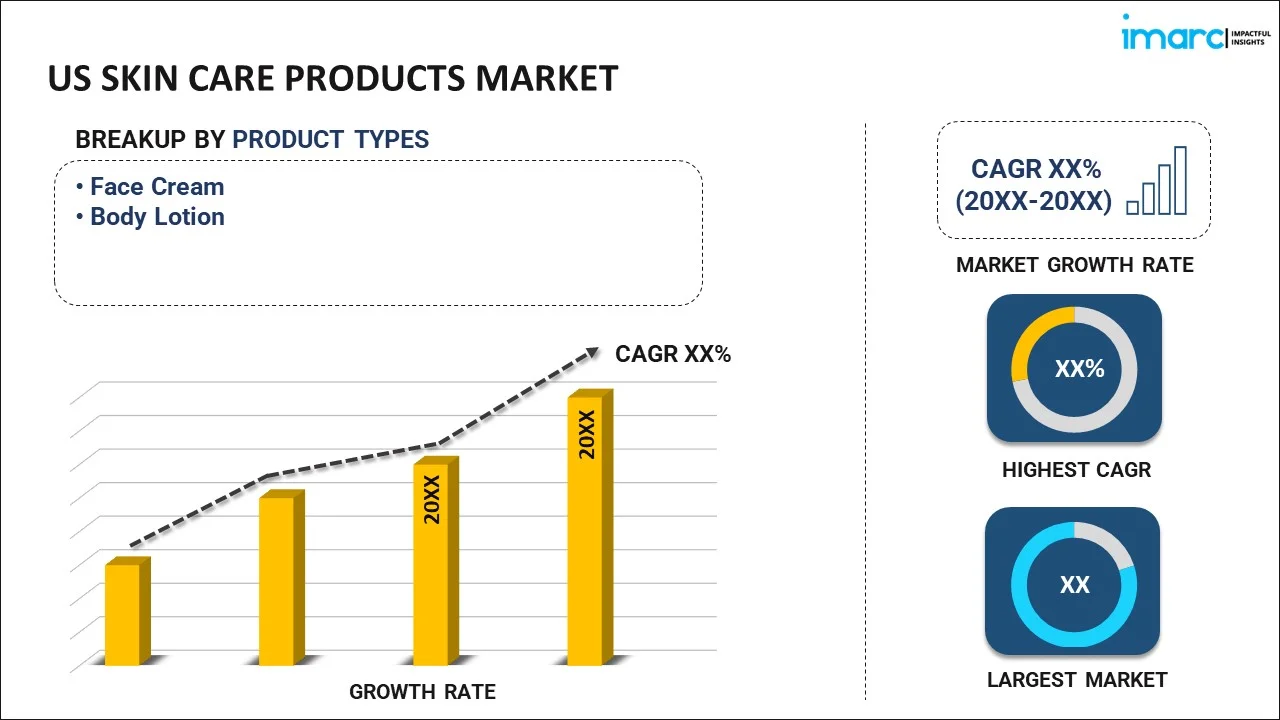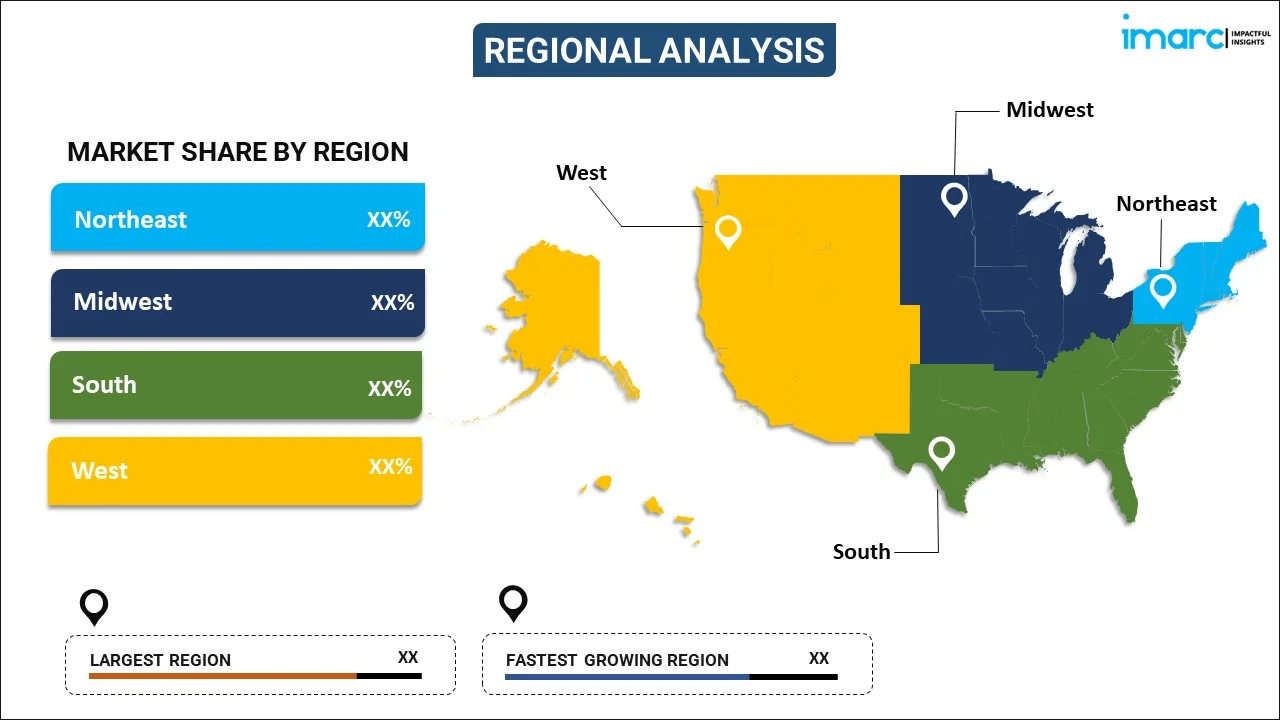
US Skin Care Products Market Report by Product Type (Face Cream, Body Lotion), Ingredient (Chemical, Natural), Gender (Male, Female, Unisex), Distribution Channel (Supermarkets and Hypermarkets, Beauty Parlours and Salons, Multi Branded Retail Stores, Online, Exclusive Retail Stores, and Others), and Region 2025-2033
Market Overview:
US skin care products market size is projected to exhibit a growth rate (CAGR) of 4.2% during 2025-2033. The rising demand for transparency in product labeling and the growing preferences among individuals towards cruelty-free and eco-friendly formulations, reflecting a broader shift towards conscious consumerism, are primarily driving the market growth across the country.
|
Report Attribute
|
Key Statistics
|
|---|---|
|
Base Year
|
2024 |
|
Forecast Years
|
2025-2033
|
|
Historical Years
|
2019-2024
|
| Market Growth Rate (2025-2033) | 4.2% |
Skin care products are formulated to nurture, safeguard, and enhance the well-being and visual appeal of the skin. They include a wide array of items, including moisturizers, cleansers, toners, serums, masks, sunscreens, etc., tailored to address distinct skin issues and uphold optimal skin health. Their primary functions involve moisturizing the skin, preventing dryness, and sustaining its innate hydration levels. Furthermore, these products play a role in refining the skin's texture and aesthetic by diminishing age-related indicators like wrinkles, fine lines, and age spots. Skincare products also act as a shield against environmental threats, such as harmful UV rays, pollution, free radicals, etc. Their efficacy extends to specific skin concerns like acne, hyperpigmentation, sensitivity, etc., fostering a healthier and more balanced complexion. Beyond their functional aspects, they offer a serene and revitalizing experience, contributing to an overall sense of well-being.
US Skin Care Products Market Trends:
The US skin care products market is primarily driven by the growing emphasis of individuals on overall wellness. Additionally, consumers are increasingly adopting skin care routines as part of their self-care practices, which is acting as another significant growth-inducing factor. Besides this, the widespread usage of products that are formulated with natural and sustainable ingredients is also bolstering the market growth across the US. Moreover, technological advancements are also shaping the market, with a notable rise in the use of artificial intelligence and personalized skin care solutions. Apart from this, brands are leveraging data-driven insights to offer customized products that cater to individual skin concerns, contributing to a more personalized and effective skin care experience. Furthermore, inclusivity and diversity are influencing product development and marketing strategies. In line with this, businesses across the country are embracing a more diverse range of skin tones and types, ensuring that their products cater to a broader consumer base. In conclusion, the rising influence of social media platforms and beauty bloggers is expected to fuel the US skincare products market over the forecasted period.
US Skin Care Products Market Segmentation:
IMARC Group provides an analysis of the key trends in each segment of the market, along with forecasts at the country level for 2025-2033. Our report has categorized the market based on product type, ingredient, gender, and distribution channel.
Product Type Insights:

- Face Cream
- Skin Brightening Cream
- Anti-Aging Cream
- Sun Protection Cream
- Body Lotion
- Mass Body Care
- Premium Body Care
- Others
The report has provided a detailed breakup and analysis of the market based on the product type. This includes face cream (skin brightening cream, anti-aging cream, and sun protection cream) and body lotion (mass body care, premium body care, and others).
Ingredient Insights:
- Chemical
- Natural
A detailed breakup and analysis of the market based on the ingredient have also been provided in the report. This includes chemical and natural.
Gender Insights:
- Male
- Female
- Unisex
The report has provided a detailed breakup and analysis of the market based on the gender. This includes male, female, and unisex.
Distribution Channel Insights:
- Supermarkets and Hypermarkets
- Beauty Parlours and Salons
- Multi Branded Retail Stores
- Online
- Exclusive Retail Stores
- Others
A detailed breakup and analysis of the market based on the distribution channel have also been provided in the report. This includes supermarkets and hypermarkets, beauty parlours and salons, multi branded retail stores, online, exclusive retail stores, and others.
Regional Insights:

- Northeast
- Midwest
- South
- West
The report has also provided a comprehensive analysis of all the major regional markets, which include Northeast, Midwest, South, and West.
Competitive Landscape:
The market research report has also provided a comprehensive analysis of the competitive landscape. Competitive analysis such as market structure, key player positioning, top winning strategies, competitive dashboard, and company evaluation quadrant has been covered in the report. Also, detailed profiles of all major companies have been provided.
US Skin Care Products Market Report Coverage:
| Report Features | Details |
|---|---|
| Base Year of the Analysis | 2024 |
| Historical Period | 2019-2024 |
| Forecast Period | 2025-2033 |
| Units | Billion USD |
| Scope of the Report | Exploration of Historical Trends and Market Outlook, Industry Catalysts and Challenges, Segment-Wise Historical and Future Market Assessment:
|
| Product Types Covered |
|
| Ingredients Covered | Chemical, Natural |
| Genders Covered | Male, Female, Unisex |
| Distribution Channels Covered | Supermarkets and Hypermarkets, Beauty Parlours and Salons, Multi Branded Retail Stores, Online, Exclusive Retail Stores, Others |
| Regions Covered | Northeast, Midwest, South, West |
| Customization Scope | 10% Free Customization |
| Post-Sale Analyst Support | 10-12 Weeks |
| Delivery Format | PDF and Excel through Email (We can also provide the editable version of the report in PPT/Word format on special request) |
Key Questions Answered in This Report:
- How has the US skin care products market performed so far and how will it perform in the coming years?
- What has been the impact of COVID-19 on the US skin care products market?
- What is the breakup of the US skin care products market on the basis of product type?
- What is the breakup of the US skin care products market on the basis of ingredient?
- What is the breakup of the US skin care products market on the basis of gender?
- What is the breakup of the US skin care products market on the basis of distribution channel?
- What are the various stages in the value chain of the US skin care products market?
- What are the key driving factors and challenges in the US skin care products?
- What is the structure of the US skin care products market and who are the key players?
- What is the degree of competition in the US skin care products market?
Key Benefits for Stakeholders:
- IMARC’s industry report offers a comprehensive quantitative analysis of various market segments, historical and current market trends, market forecasts, and dynamics of the US skin care products market from 2019-2033.
- The research report provides the latest information on the market drivers, challenges, and opportunities in the US skin care products market.
- Porter's five forces analysis assist stakeholders in assessing the impact of new entrants, competitive rivalry, supplier power, buyer power, and the threat of substitution. It helps stakeholders to analyze the level of competition within the US skin care products industry and its attractiveness.
- Competitive landscape allows stakeholders to understand their competitive environment and provides an insight into the current positions of key players in the market.
Need more help?
- Speak to our experienced analysts for insights on the current market scenarios.
- Include additional segments and countries to customize the report as per your requirement.
- Gain an unparalleled competitive advantage in your domain by understanding how to utilize the report and positively impacting your operations and revenue.
- For further assistance, please connect with our analysts.
 Inquire Before Buying
Inquire Before Buying
 Speak to an Analyst
Speak to an Analyst
 Request Brochure
Request Brochure
 Request Customization
Request Customization




.webp)




.webp)












